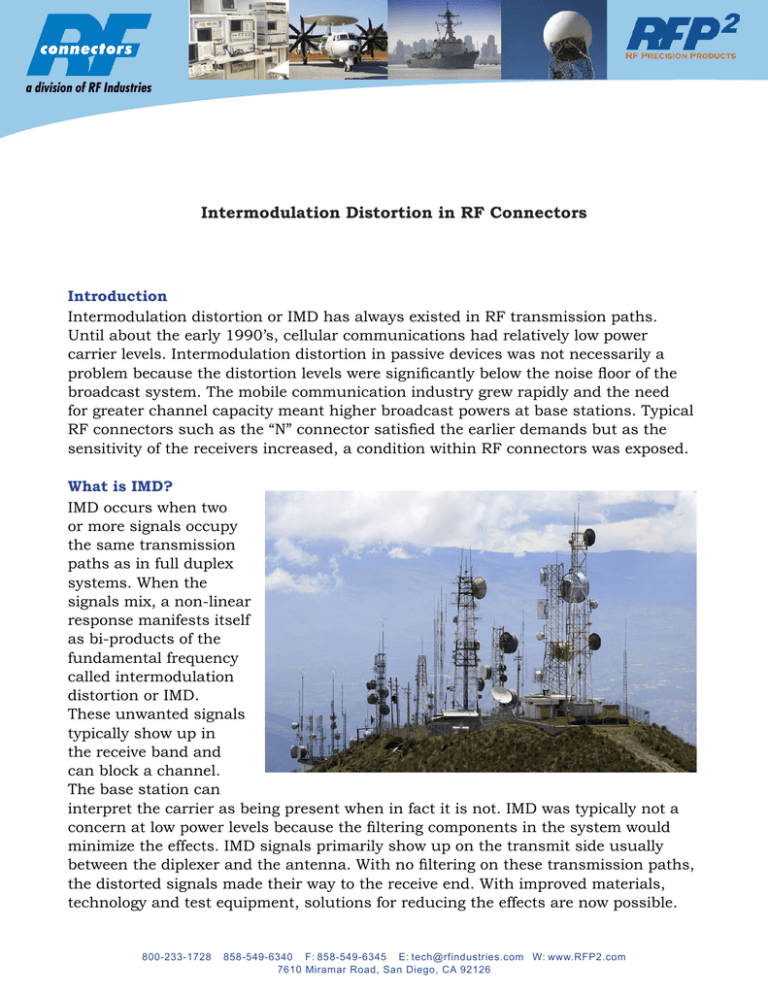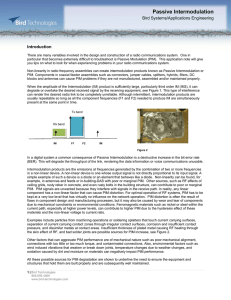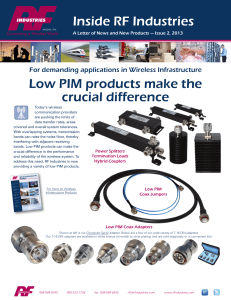Intermodulation Distortion in RF Connectors
advertisement

a division of RF Industries Intermodulation Distortion in RF Connectors Introduction Intermodulation distortion or IMD has always existed in RF transmission paths. Until about the early 1990’s, cellular communications had relatively low power carrier levels. Intermodulation distortion in passive devices was not necessarily a problem because the distortion levels were significantly below the noise floor of the broadcast system. The mobile communication industry grew rapidly and the need for greater channel capacity meant higher broadcast powers at base stations. Typical RF connectors such as the “N” connector satisfied the earlier demands but as the sensitivity of the receivers increased, a condition within RF connectors was exposed. What is IMD? IMD occurs when two or more signals occupy the same transmission paths as in full duplex systems. When the signals mix, a non-linear response manifests itself as bi-products of the fundamental frequency called intermodulation distortion or IMD. These unwanted signals typically show up in the receive band and can block a channel. The base station can interpret the carrier as being present when in fact it is not. IMD was typically not a concern at low power levels because the filtering components in the system would minimize the effects. IMD signals primarily show up on the transmit side usually between the diplexer and the antenna. With no filtering on these transmission paths, the distorted signals made their way to the receive end. With improved materials, technology and test equipment, solutions for reducing the effects are now possible. 800-233-1728 858-549-6340 F: 858-549-6345 E: tech@rfindustries.com W: www.RFP2.com 7610 Miramar Road, San Diego, CA 92126 Understanding PIM The basics of Passive IM (PIM) are the non-linear behavior in passive devices which causes the fundamental frequency to become distorted. Figure 1 shows the linear vs. non-linear response. The distortion is caused by the mixing of fundamental frequencies at high power levels in the time domain which then generate nth order products in the frequency domain. These products can also be referred to as harmonics Fig. 1: Linear vs. Non-Linear Response1 Intermodulation products are multiples of the fundamental frequencies. 1st through 5th order harmonics are the addition to or subtraction of the carrier signals. 1st order f1, f2 2 f1+f2, f2-f1 nd order 3rd order 2f1-f2, 2f2-f1 4th order 2f2+2f1, 2f2-2f1 5th order 3f1+2f2, 3f2-2f1 etc Odd order harmonics show up in the receive bands and are the root of PIM performance so for this discussion we will concentrate on them. Calculating the harmonics of two carrier signals are as follows: 3rd Order IMP = 2f1-f2, 2f2-f1 5th Order IMP = 3f1-2f2, 3f2-2f1 7th Order IMP = 4f1-3f2, 4f2-3f1 etc., An example of the calculated 3rd order IMP in the PCS band is shown below. When a multiple carrier transmit path is also the receive path, the signals can mix to produce 3rd order harmonics. (IM3) In this example, they occur at 1870 MHz. 800-233-1728 858-549-6340 F: 858-549-6345 E: tech@rfindustries.com W: www.RFP2.com 7610 Miramar Road, San Diego, CA 92126 With fundamental frequencies being as follows: F1 = 1930 MHz Eq. 1 F2 = 1990 MHz 2f1-f2 IM3 = -1870 MHz Figure 2 shows a spectrum of 2 tone IM products. What causes PIM? As stated earlier, the non-linear behavior and mixing of signals through passive devices are the main cause. There are however controllable measures to minimize the effects. Wireless communication carriers loose millions of dollars when their systems shut down or malfunction. When simplex antennas are used, they become the most susceptible to PIM interference for obvious reasons. Duplex antennas can reduce the risk of cross polarization where isolation between antennae improve performance. Controlling the processes of how passive devices are designed and built can address PIM performance issues. Some causes of PIM through connectors are as follows: • Poor contact junctions: Cracks or gaps on conductor paths; even at the microscopic level can cause PIM levels to rise. This is especially important for right angle contacts. Mating surfaces on contacts that don’t provide a sound 360 degree attachment is another concern. • Poor contact pressure: Insufficient pin to contact mating pressure and irregular contact mating surfaces. • Dissimilar metals in the conductor paths: Cause oxide-metal-oxide formations between layers of the surface plating and base material. • The use of ferromagnetic materials such as Nickel cause non-linear voltage to current ratios. Stainless steel, depending on the grade may generate a hysteresis effect. In an electromagnetic environment, a magnetic memory remains within the EM fields affecting the voltage to current ratios which again contributes to the non-linear response. • Cleanliness: Contaminated surfaces, insufficient surface plating or contaminated plating contributes to non-linear behavior. • Crimping: On cable jumpers, crimped contacts create multiple contact points resulting in air gaps around the cables’ center conductor. These gaps cause PIM levels to rise when dynamic testing is performed. 800-233-1728 858-549-6340 F: 858-549-6345 E: tech@rfindustries.com W: www.RFP2.com 7610 Miramar Road, San Diego, CA 92126 Remedies for low PIM • Contact surfaces need to be clean, smooth and plated with premium platings like White Bronze, Silver or a similar copper alloy based coating. Plating should be sufficient enough to allow low resistivity to signal propagation. (skin effect) • Connector components and conductor paths should be machined to strict tolerances to minimize surface roughness. • Contact joints need to be sound connections with no air gaps. In right angle connectors, one piece swept contacts are preferred. • Avoid the use of ferromagnetic materials or stainless in the conductor paths. • With cables, soldering the connector contacts form gas tight and reliable extensions of the cables’ center conductor. • Machined connectors made from copper and copper alloys allow good plating adhesion and minimize electro-potentials between base metals and plated surfaces. • Avoid the use of dissimilar metals. Corrosion to conductors is accelerated when subjected to high currents in humid environments. PIM Standards The IEC Technical Committee’s working group has developed a generic test procedure for measuring PIM. The test equipment and set-ups have evolved over the years. The first renditions had several components linked together to form a model for PIM testing. In its infancy, it proved to be a very expensive choice to make although necessary at the time. This type of set up was confined to the lab due to the amount of real estate it occupied. Today, packetized test units are available and many were designed for mobility. Field tests were made possible with these units. There are always pros and cons with test equipment. The pros are the convenience and portability of the units. The cons are cost and limited bandwidth. The mobile test sets I’ve encountered thus far are configured for specific bands. These units are set up to measure frequency allocations such as the PCS or GSM bands. Albeit good for some carriers, but multi-band units would be better suited for most concerned. Only a matter of time for the portable units to evolve into the broadband realm but not yet practical due to the expensive large and heavy filters that make up the test set. Reflective and transmitted test scenarios are possible with the current architecture. Specifying PIM Levels What is considered an acceptable PIM level? The short answer is this: Telecommunication, Mobile and Wireless providers set the bar right now. Soon, the IEC Technical committee will release documents that govern the PIM levels and should establish a base point of reference for test and acceptability requirements. The exact release date is unknown. PIM levels will probably be specified in terms of -dBc or -dBm. There are test and measurement manufacturers that produce PIM testers because of the demand from the aforementioned service providers. Acceptable measured levels are an arbitrary number at present. What’s considered a good PIM level to one cellular carrier may or may not be relevant to another. 800-233-1728 858-549-6340 F: 858-549-6345 E: tech@rfindustries.com W: www.RFP2.com 7610 Miramar Road, San Diego, CA 92126 Measuring PIM The measuring systems are made up of very sophisticated and expensive components. They must employ extremely sensitive filtering devices while providing clean amplification. In other words, it is imperative for the test set to have a very low intermodulation noise floor. PIM analyzers typically display the measured values in -dBc or -dBm. The -dBc value is the addition of the input power relative to the measured -dBm level. Figure 3 shows a test report from a Boonton PIM tester.2 An RF Industries’ 7-16 DIN adapter with white bronze plating was used as the test sample. The test set is configured to measure PIM in the PCS band. The 3rd order PIM value at 1870 MHz shown in “Green” is the -dBc level relative to the -119.6dBm value. The “Red” line set to -150dBc is a benchmark value. Carrier powers are those levels above the reference power level. Power in -dBm is referenced to 0dBm or 1mW. A conversion for Watts to dBm is shown in Eq. 2: Log (mW)*10 Therefore, 20,000 mW = +43dBm (20 watts) Fig. 3 It’s important to note that one PIM analyzer result does not necessarily guarantee a similar result when tested on another manufacturers unit. Other things to consider are the types of testing performed. i.e., testing in a lab environment vs. testing performed in the field. There have been cases made and feedback reported from field technicians about objects such as metal or wood structures and other influences that effect PIM performance. Dynamic vs. static testing results can vary significantly and are subject to expert opinion when deciding pass/fail parameters. 800-233-1728 858-549-6340 F: 858-549-6345 E: tech@rfindustries.com W: www.RFP2.com 7610 Miramar Road, San Diego, CA 92126 Connectors used for low PIM service As mentioned in the beginning of this article, the “N” connector was primarily used and for all intents and purposes, was a steady and reliable workhorse connector. From Europe came 7-16 DIN connectors. Designed for high power applications, it later presented many advantages over other RF connectors. 7-16 refers to the conductor sizes in millimeters. A large air gap in the interface yields average power levels of 15KW and higher depending on frequency of operation. Superior design and materials made this style the connector of choice for high power RF applications. Well suited for mountain top mobile and wireless communication centers, it found its mark in America and is still in high demand. In our article titled “White Bronze Plating” a case was made to improve IM performance.3 The choice to move to white bronze plating was an all around product improving exercise and is a good fit for this industry. 7-16 DIN connectors were uniquely designed for rugged service and are the preferred connectors for low PIM service. Controlled machining and plating practices should guarantee low PIM. The guidelines described in this article should guarantee steady state performance. Conclusion Some of the cause and affects of PIM performance were presented. Current methods for minimizing these effects offer possibilities that were not available prior to the infrastructure of cellular communication networks. Employing reasonably low cost manufacturing methods, materials and controlled processes should yield an acceptable product line with expected low IMD performance. The IEC technical committee offers a test scenario for cable and connectors described in this document: IEC 62047. The standards for test and acceptability requirements are due to be released soon. It is my belief that a working group or committee will act as contributing consultants to the IEC as additional methods become available. The proliferation of signals crowding the airwaves is imminent. Testing for higher orders of PIM should make way for more sensitive test systems. The possibility of multi-tone testing has been discussed and is more reflective of real world conditions. Intermodulation has become an important factor of connector performance and is a major concern for cellular network carriers. Service providers need to operate at optimal levels to ensure subscribers experience the best in call quality in this hugely competitive market. Ronnie Rice, RF Technical Support Manager RF Precision Products by RF Connectors, A Division of RF Industries, San Diego, California References and credits: 1 Graphics courtesy of Tyco Electronics 2 Testing performed on location at RF Industries RFP2 Division 3 More on the subject found in this article; “White Bronze Plating” 800-233-1728 858-549-6340 F: 858-549-6345 E: tech@rfindustries.com W: www.RFP2.com 7610 Miramar Road, San Diego, CA 92126




